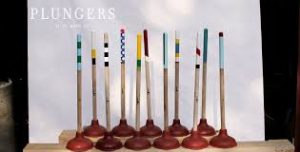When does a plunger become controversial art? Fair use, the right to limited re-use of copyrighted material without permission or payment, permits not only more efficient work flows but also innovation. Artists are among those who understand the power of unlicensed quotation under fair use.
To celebrate Fair Use/Fair Dealing Week, CMSI is publishing excerpts from the just-released second edition Reclaiming Fair Use: How to Put Balance Back in Copyright (University of Chicago Press). Here’s one:
Fair use came to the rescue not once but twice for Rebekah Modrak, a visual artist who teaches at the University of Michigan.
Spoof.

Plungers from Rebekah Modrak’s ReMade Co.
She needed it first when she created art that incorporated copyrighted material. Her work spoofed the overexemplifying hipster-Brooklyn site Best Made Co. She invented a parody company Re Made Co, and created a side-by-side video of Best Made’s video ad for an artisanal axe and Re Made’s version promoting…an artisanal plunger. Her site, remadeco.org, advertised plunger-centric products poking sly fun at the pretensions of Best Made.
After getting a cease-and-desist letter from Best Made, she turned to her lawyers at the University of Michigan. Her university’s lawyers thought the project was hilarious, and they welcomed the opportunity to support her fair uses. She was able to treat the cease-and-desist as the nuisance-nastygram it was.
Second time around.

The journal that published Rebekah Modrak’s article, employing fair use.
She then wrote about her experience for a Routledge academic journal, Consumption Markets and Culture. She included an illustration from her video, featuring a side-by-side image of the original Best Made ad and her own parody.
At first, the Routledge editors told her that although she would have to get permission for the Best Made side of the artwork. The irony of the fact that the journal article recounted why she did not need permission was apparently lost on them. But then she took the Code of Best Practices in Fair Use for the Visual Arts, which had recently been created by the College Art Association, to the editors. It helped them understand how to apply fair use to her illustration. The journal published the work with illustrations without further ado.
Being able to employ fair use, Modrak said, “strengthened my own scholarship. I thought that Routledge would come back and say, ‘Sorry, we’re a UK publisher; fair use isn’t applicable here,’ but instead, we were able to inform Routledge’s practice! How awesome is that!”
Do you want to understand how to employ the U.S. copyright doctrine of fair use in digital art? Read the Code of Best Practices in Fair Use for the Visual Arts. For more stories like this, and for a fuller background on how visual artists came together to create their code, and how it changed their field, check out Reclaiming Fair Use, second edition.
